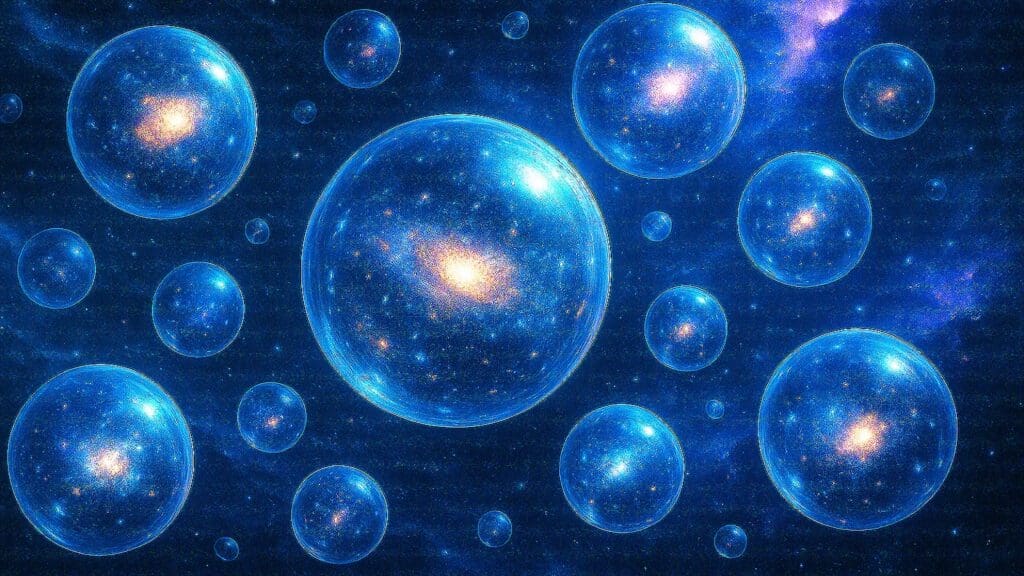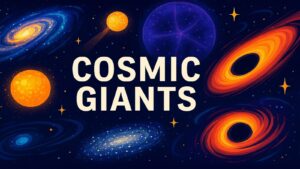Table of Contents
Introduction: Cosmic Inflation That Shattered The Universe
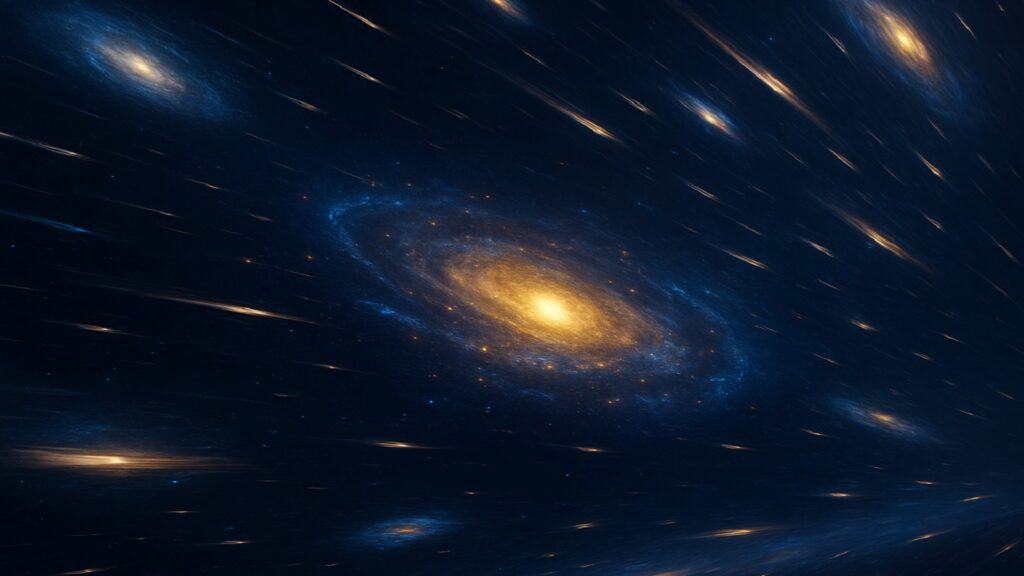
The universe began not with a bang, but with a stretch. In the first fraction of a second after the Big Bang, space itself expanded faster than light could travel through it. This process, called cosmic inflation, transformed a region smaller than an atom into something larger than a grapefruit in less time than it takes light to cross a proton.
Cosmic inflation is one of the most powerful forces of the Universe that has shaped the cosmos the way it is. Alan Guth first proposed cosmic inflation in 1980 to solve several puzzles about our universe. Why does the cosmos look so uniform in temperature? Why is space so geometrically flat? The answer lies in that violent stretching of space-time during the universe’s infancy. But the cosmic inflation may have done more than solve these problems. It might have shattered the very notion of a single universe.
Modern physicists increasingly suspect that cosmic inflation did not create just one universe, but countless others. Each pocket of space that underwent inflation became its own reality, complete with its own laws of physics and fundamental constants. These parallel worlds exist beyond our cosmic horizon, forever separated by the expanding void between them.
The mathematics of cosmic inflation suggests that this process continues eternally in some regions of space while ending in others. Where it ends, universes like ours emerge. Where it continues, space keeps stretching, creating new regions where inflation can finally halt and spawn more universes. This eternal dance of expansion and universe creation paints a picture of reality far stranger than our ancestors ever imagined.
Table 1: Key Properties of Cosmic Inflation
| Property | Description | Duration | Effect |
|---|---|---|---|
| Expansion Rate | Exponential doubling every 10^-37 seconds | 10^-36 to 10^-32 seconds | Stretched quantum fluctuations to cosmic scales |
| Temperature | Dropped from 10^27 K to 10^22 K | Throughout inflation | Cooled universe to allow structure formation |
| Spatial Curvature | Flattened from curved to nearly flat | Entire inflationary period | Created observed geometric flatness |
| Causal Horizons | Regions lost contact with each other | Permanent after inflation | Isolated distant cosmic regions |
| Vacuum Energy | Drove expansion through false vacuum | Until vacuum decay | Powered inflationary expansion |
1. Cosmic Inflation: When the Cosmos Lost Touch with Itself
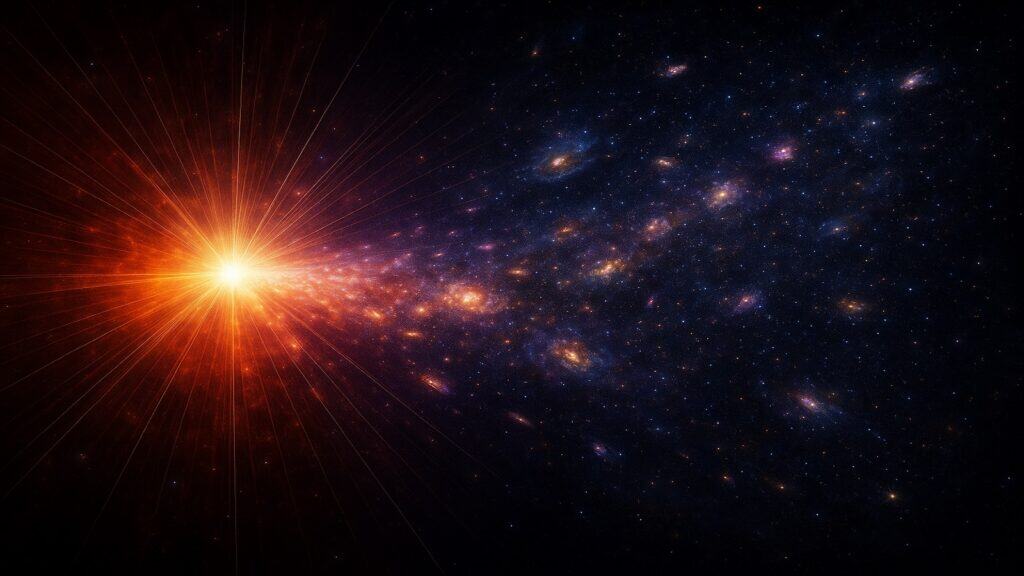
During cosmic inflation, space expanded so rapidly that light could not keep pace. Regions of the universe that were once in contact suddenly found themselves beyond each other’s reach. The speed of light, usually the ultimate speed limit, became irrelevant as space itself raced away faster than photons could travel.
This created what physicists call causal horizons. Beyond these boundaries, events in one region cannot influence events in another. The cosmic microwave background radiation shows us the last moment when light could travel freely through space, roughly 380,000 years after the Big Bang. But even this ancient light comes from regions that lost contact with each other during inflation.
The implications are profound. If the cosmic inflation occurred at different rates in different regions, or if it ended at different times, these isolated pockets would evolve into separate universes. Each would have its own physics, its own matter and energy distributions, and its own fate. The mathematical models developed by Andrei Linde and others suggest that this process creates an infinite number of causally disconnected regions.
These horizon problems explain why our observable universe appears so remarkably uniform. The cosmic microwave background exhibits temperature fluctuations of merely one part in 100,000 throughout the whole sky. Without the cosmic inflation, distant regions would have no way to coordinate their temperatures. But if these regions were once close together before the cosmic inflation stretched them apart, their similarity makes perfect sense.
The fracturing of space-time during inflation also explains why we cannot see evidence of other universes. They exist beyond our cosmic horizon, separated by regions of space that are expanding faster than light can cross them. This isolation is not temporary but permanent, creating a cosmic loneliness that defines the boundaries of our observable reality.
Table 2: Causal Horizon Effects During Cosmic Inflation
| Physical Process | Before Inflation | During Inflation | After Inflation | Observable Impact |
|---|---|---|---|---|
| Light Travel Time | 10^-43 seconds across observable region | Information exchange impossible | Regions remain disconnected | CMB temperature uniformity |
| Particle Horizons | All regions in causal contact | Horizons shrink exponentially | Permanent isolation created | Explains large-scale homogeneity |
| Correlation Length | Quantum scale correlations | Stretched to macroscopic scales | Frozen into cosmic structure | Galaxy formation patterns |
| Temperature Equilibrium | Thermal contact possible | Regions lose thermal contact | No further equilibration | Uniform CMB temperature |
| Causality Breakdown | Events can influence each other | Causal connection severed | Permanent causal isolation | Independent evolution of regions |
2. Cosmic Inflation and Bubble Realities: Parallel Universes from Vacuum Decay
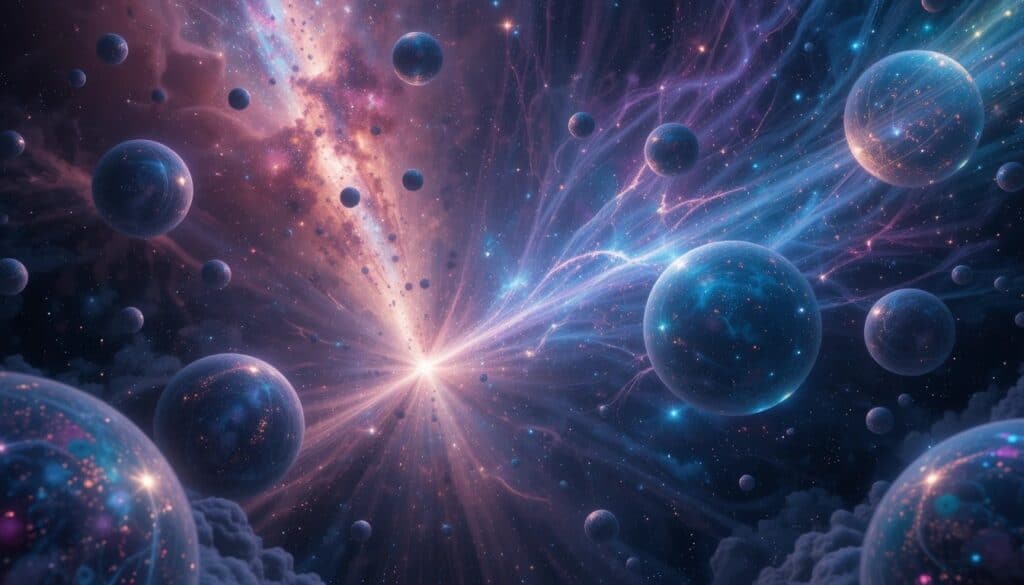
The quantum vacuum is not empty space but a seething foam of virtual particles and energy fluctuations. During cosmic inflation, this vacuum existed in what physicists call a false vacuum state. Like a ball balanced on a hilltop, this state was unstable and eventually decayed into a lower energy configuration.
When the false vacuum decayed, it created bubbles of true vacuum that expanded at nearly the speed of light. Each bubble became a separate universe with its own physical laws and constants. The walls of these bubbles moved through space-time like cosmic tsunamis, transforming everything they touched into new forms of matter and energy.
Eternal inflation theory, developed by physicists like Alexander Vilenkin, suggests that this bubble formation continues forever. While some regions of space transition from false to true vacuum, others remain in the false vacuum state and continue inflating. This creates an endless network of bubble universes, each isolated from the others by regions of ongoing inflation.
The process resembles a pot of boiling water, where bubbles of steam form and separate while the water continues to boil. Each bubble universe emerges with its own unique properties, determined by the specific way the vacuum decayed in that region. The fundamental constants of physics, like the strength of gravity or the mass of the electron, could vary from bubble to bubble.
This bubble multiverse represents a vast archipelago of realities, each island completely isolated from the others. Some bubbles might contain universes similar to ours, while others could have physics so different that matter as we know it cannot exist. The eternal nature of inflation ensures that this cosmic archipelago continues to grow, adding new islands of reality to an already infinite ocean of possibilities.
Table 3: Vacuum Decay and Bubble Universe Formation
| Vacuum State | Energy Density | Stability | Rate of Cosmic Inflation | Universe Formation |
|---|---|---|---|---|
| False Vacuum | 10^120 J/m³ | Metastable | Exponential expansion | Delayed until decay |
| Intermediate Vacuum | 10^80 J/m³ | Temporarily stable | Moderate expansion | Partial universe formation |
| True Vacuum | 10^-10 J/m³ | Absolutely stable | Expansion ceases | Full universe emerges |
| Vacuum Bubble Wall | Variable gradient | Unstable interface | Light-speed propagation | Defines universe boundaries |
| Post-Decay Region | Background cosmological | Stable ground state | Hubble expansion | Normal cosmic evolution |
3. Space Time Tuning: How Cosmic Inflation and Quantum Fluctuations Wrote the Rules of Reality
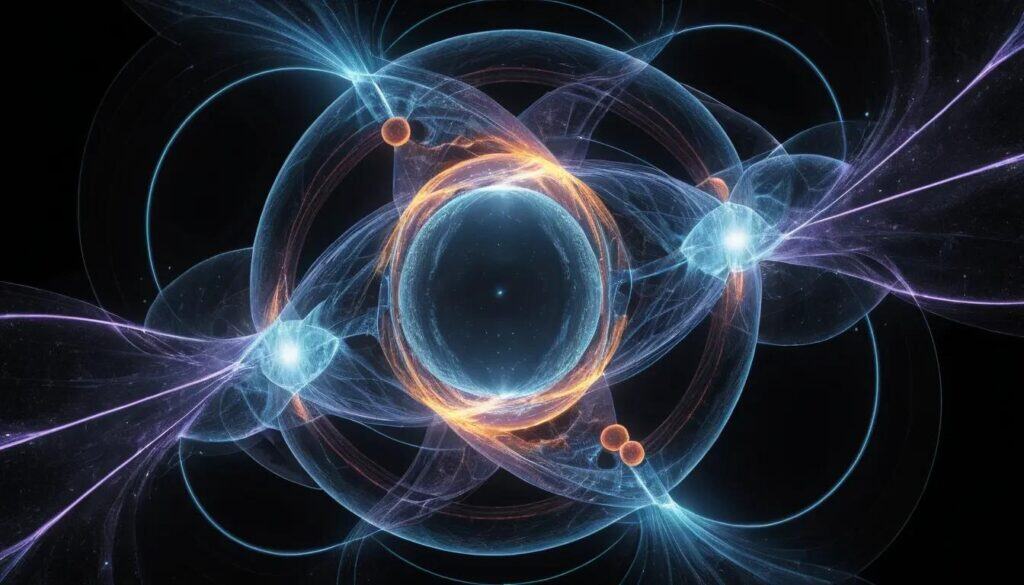
Quantum mechanics tells us that empty space is never truly empty. Even in an ideal vacuum, virtual particles emerge and disappear, resulting in minute fluctuations in energy and matter. During cosmic inflation, these microscopic quantum fluctuations were stretched to enormous scales, becoming the seeds of galaxies and cosmic structure.
But these fluctuations may have done more than create the large-scale structure of our universe. They might have fine-tuned the fundamental constants of physics themselves. The strength of gravity, the speed of light, the mass of elementary particles – all these values could have been set by quantum fluctuations during the cosmic inflation.
Different regions of space would have experienced different quantum fluctuations, leading to different values for these fundamental constants. This process, known as stochastic inflation, suggests that the laws of physics are not universal but vary from region to region across the multiverse. Our universe happens to have constants that allow for the existence of atoms, stars, and life, but other regions might have very different physics.
The anthropic principle provides one way to understand this apparent fine-tuning. If the cosmic inflation created countless universes with different physical constants, we naturally find ourselves in one of the rare regions where the constants allow for our existence. Universes with different values might exist, but they would be empty of observers to contemplate their existence.
This quantum tuning process represents a fundamental randomness built into the structure of reality itself. The roll of cosmic dice during inflation determined not just what galaxies would form, but what kinds of atoms could exist and what forces would govern their interactions. The multiverse becomes a vast laboratory where nature experiments with different versions of physics.
Table 4: Quantum Fluctuation Effects on Fundamental Constants
| Physical Constant | Standard Value | Possible Range | Effect of Variation | Universe Viability |
|---|---|---|---|---|
| Fine Structure Constant | 1/137 | 1/100 to 1/200 | Alters atomic binding | Narrow stable range |
| Gravitational Constant | 6.67 × 10^-11 N⋅m²/kg² | ±50% variation | Changes stellar evolution | Critical for star formation |
| Electron Mass | 9.11 × 10^-31 kg | ±10% variation | Affects atomic structure | Essential for chemistry |
| Proton-Electron Mass Ratio | 1836 | 1500 to 2200 | Determines nuclear stability | Required for complex atoms |
| Cosmological Constant | 1.3 × 10^-52 m^-2 | 10^-120 to 10^-50 m^-2 | Controls expansion rate | Extremely fine-tuned |
4. Space Time Foam: Cosmic Inflation, Micro-Bubbles and Baby Universes in the Void
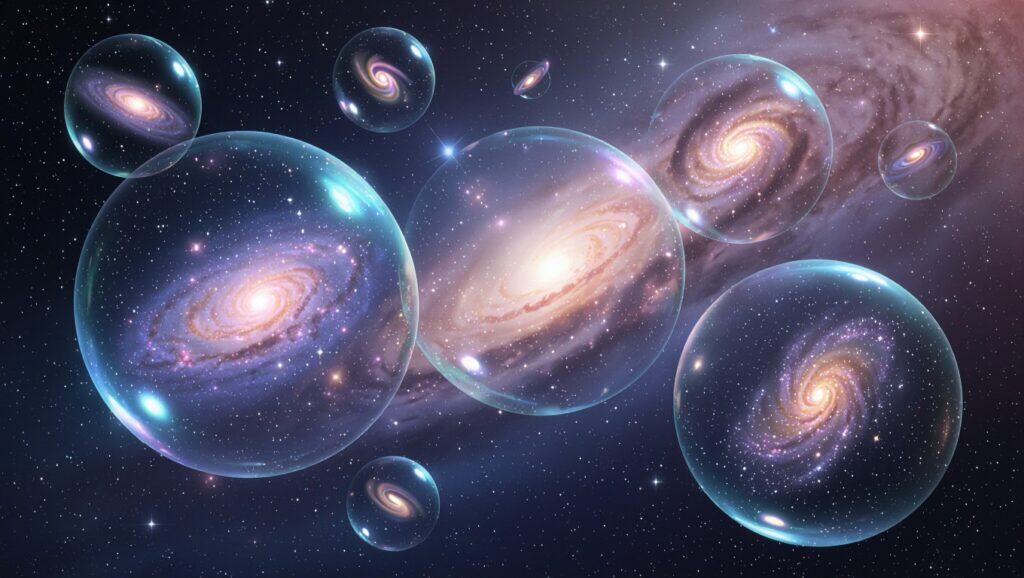
At the smallest scales of space and time, quantum mechanics suggests that the fabric of space-time becomes a foam of virtual particles and fluctuating geometry. During cosmic inflation, this quantum foam might have served as a nursery for baby universes, each one budding off from our own space-time like bubbles forming in champagne.
The mathematics of quantum gravity, particularly in the context of string theory, allows for the possibility that quantum fluctuations can create closed loops of space-time. These loops, no larger than the Planck length, could inflate into full-sized universes complete with their own space and time. The process would be invisible to us, as these baby universes would be completely disconnected from our own space-time.
Sidney Coleman and Frank De Luccia showed that quantum tunneling could create such disconnected regions during cosmic inflation. Their work suggests that the quantum foam of space-time might be constantly giving birth to new universes, each one starting its own inflationary phase and potentially spawning its own offspring. This creates a fractal structure of reality where universes exist within universes at every scale.
The baby universe hypothesis also provides a potential solution to the black hole information paradox. Information that falls into a black hole might not be destroyed but could seed the formation of a new universe. This would preserve the quantum mechanical principle that information cannot be destroyed while explaining where that information goes when it crosses the event horizon of a black hole.
This foam-like structure of space-time suggests that reality is far more complex than our everyday experience suggests. The smooth space-time of Einstein’s relativity might be only an approximation, valid at large scales but breaking down at the quantum level into a seething cauldron of baby universes and virtual particles.
Table 5: Quantum Foam and Baby Universe Properties
| Scale | Size | Duration | Energy Density | Formation Mechanism |
|---|---|---|---|---|
| Planck Scale | 10^-35 meters | 10^-43 seconds | 10^113 J/m³ | Quantum fluctuations |
| Virtual Particles | 10^-30 meters | 10^-38 seconds | 10^100 J/m³ | Heisenberg uncertainty |
| Quantum Loops | 10^-25 meters | 10^-33 seconds | 10^85 J/m³ | Topological defects |
| Micro-Wormholes | 10^-20 meters | 10^-28 seconds | 10^70 J/m³ | Spacetime curvature |
| Baby Universes | 10^-15 meters | 10^-23 seconds | 10^55 J/m³ | Inflationary nucleation |
5. Echoes of Cosmic Inflation: The Unfinished Symphony of the Multiverse
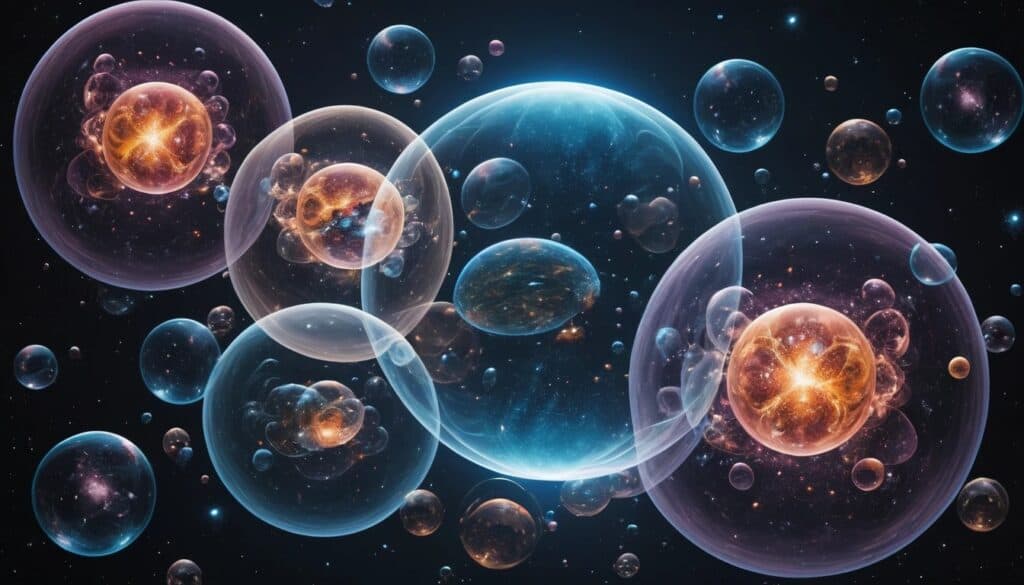
The cosmic microwave background radiation carries the faint afterglow of the Big Bang, providing a snapshot of the universe when it was only 380,000 years old. But hidden within this ancient light might be echoes from other universes, subtle patterns that reveal the existence of parallel realities beyond our cosmic horizon.
String theory suggests that the fundamental building blocks of reality are not point particles but tiny vibrating strings. The distinct vibration patterns of these strings generate the diverse particles and forces that we observe. In the context of the multiverse, each universe might resonate with different harmonic frequencies, like instruments in a vast cosmic orchestra.
During the cosmic inflation, collisions between bubble universes might leave subtle imprints in the cosmic microwave background. These collision signatures would appear as circular patterns in the temperature map of the ancient universe. While no definitive evidence for such collisions has been found, several research groups have reported possible candidates that warrant further investigation.
The mathematics of eternal cosmic inflation predicts that such collisions are inevitable. As bubble universes expand through the inflating space-time, they must eventually encounter each other. The resulting collision would create shock waves that propagate through both universes, leaving permanent scars in their respective cosmic microwave backgrounds.
These echoes from other universes represent our only potential window into the larger multiverse. While we cannot directly observe other universes, we might be able to detect their indirect effects on our own cosmic evolution. The search for these subtle signatures has become one of the most active areas of modern cosmology, offering the tantalizing possibility of empirical evidence for the multiverse.
Table 6: Theoretical Collision Signatures in Cosmic Microwave Background
| Signature Type | Observable Effect | Expected Size | Detection Status |
|---|---|---|---|
| Circular Temperature Anomalies | Cold or hot spots in circular patterns | 0.5 to 5 degrees | Possible candidates identified |
| Gravitational Wave Echoes | Ripples in space time geometry | Wavelengths of cosmic horizon | Not yet detected |
| Polarization Patterns | Organized swirling in CMB polarization | Angular scales of 1-10 degrees | Under investigation |
| Spectral Distortions | Deviations from perfect blackbody spectrum | Frequency-dependent temperature shifts | Future missions required |
| Magnetic Field Imprints | Correlated magnetic field patterns | Large-scale coherent structures | Theoretical predictions only |
6. Cosmic Inflation and Space Time Variations: Varying Constants in Parallel Realities
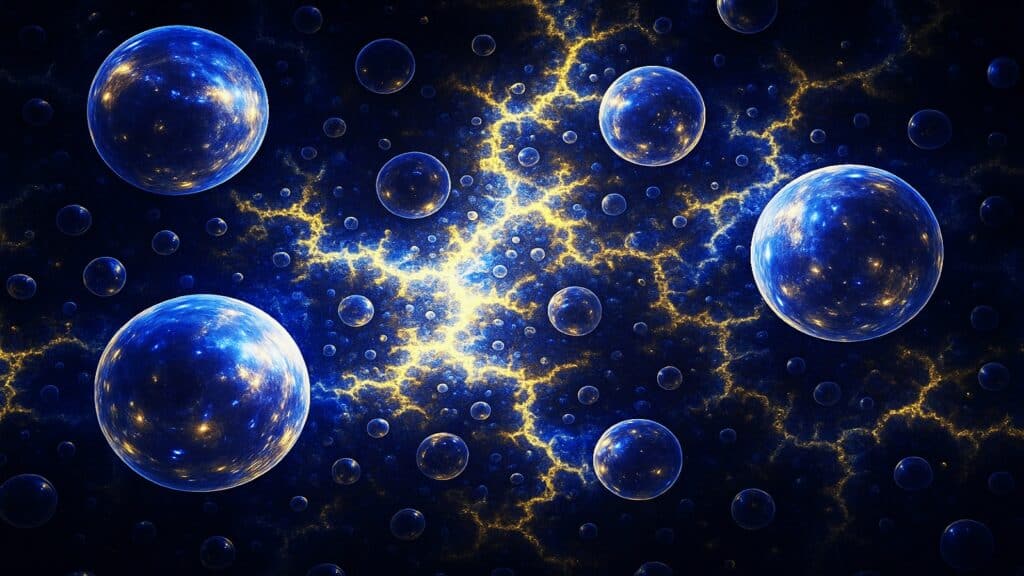
The essential constants of physics seem to be consistent throughout our observable universe. The speed of light, the strength of gravity, the mass of the electron – these values seem to be the same everywhere we look. But cosmic inflation might have created regions where these constants take on different values, leading to universes with radically different physics.
The process begins with quantum fluctuations in scalar fields during cosmic inflation. These fields, similar to the Higgs field that gives particles their mass, could have different values in different regions of space. As the cosmic inflation ended and these fields settled into their final values, they would have determined the fundamental constants of physics for each region.
A universe with a slightly stronger gravitational force might never form stable atoms, as electrons would be pulled too strongly toward atomic nuclei. Conversely, a universe with weaker gravity might produce only hydrogen and helium, never forming the heavier elements necessary for rocky planets and complex chemistry. The speed of light could vary as well, potentially creating universes where causality operates under different rules.
The anthropic landscape of string theory provides a framework for understanding how these variations might arise. String theory anticipates an extensive array of potential vacuum states, with each state linked to a distinct set of physical constants. Cosmic inflation might have explored many of these possibilities, creating a multiverse where every mathematically allowed combination of constants is realized somewhere.
This variation of physical laws throughout the multiverse poses a challenge to our comprehension of what defines the universality of physics. Instead of discovering the one true set of natural laws, we might be exploring just one small corner of a vast space of possible physics. The constants we measure in our universe might be no more fundamental than the local weather, varying from place to place across the cosmic landscape.
Table 7: Fundamental Constant Variations Across Multiverse
| Universe Type | Gravity Strength | Light Speed | Particle Masses | Atomic Structure | Complexity Level |
|---|---|---|---|---|---|
| Our Universe | Standard | 3×10^8 m/s | Standard model | Stable atoms | Life-permitting |
| High-Gravity Universe | 100x stronger | 3×10^8 m/s | 10x heavier | Compact atoms | Limited chemistry |
| Fast-Light Universe | Standard | 10×10^8 m/s | Standard | Stable atoms | Accelerated evolution |
| Weak-Force Universe | Standard | 3×10^8 m/s | Lighter leptons | Fragile atoms | Simple structures |
| Heavy-Electron Universe | Standard | 3×10^8 m/s | 10x electron mass | No stable atoms | Elementary particles only |
7. Cosmic Inflation and Fractals: Infinite Universes Within Universes
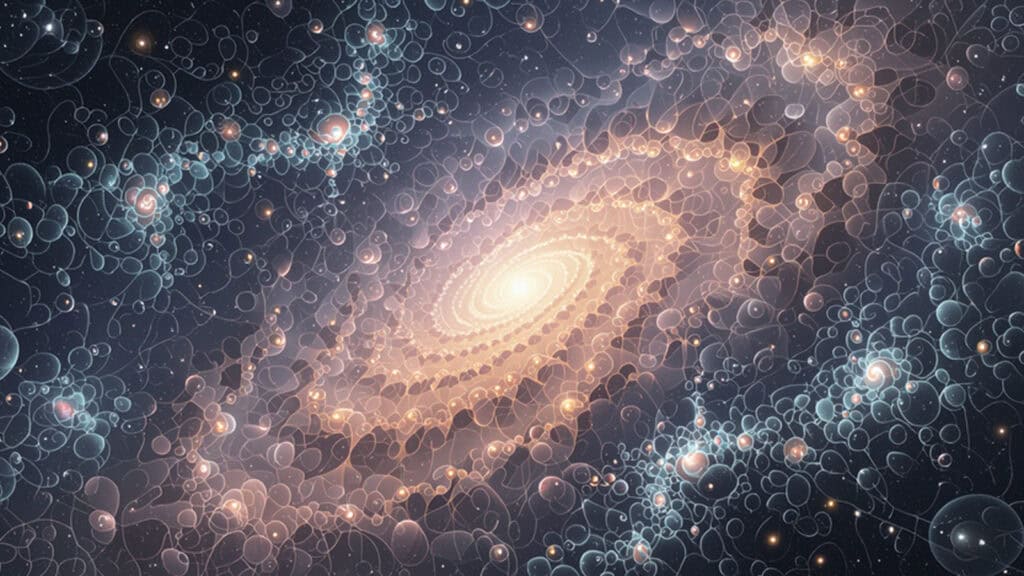
Mathematics reveals that cosmic inflation might not create just parallel universes but nested hierarchies of realities, each containing smaller versions of the same pattern. This fractal structure suggests that the multiverse resembles a cosmic Russian doll, with universes containing sub-universes that themselves contain even smaller realities.
The fractal nature of inflation emerges from the scale-invariant properties of quantum fluctuations. During inflation, fluctuations on all scales are stretched to macroscopic sizes simultaneously. This creates a self-similar pattern where the same statistical properties appear at every level of magnification, like the coastline of a continent that shows similar roughness whether viewed from space or through a microscope.
Recursive cosmic inflation models suggest that this fractal structure continues indefinitely. Each universe that forms through inflation contains regions that can undergo their own inflationary phase, creating sub-universes within the larger structure. These sub-universes can then spawn their own offspring, creating an infinite hierarchy of nested realities.
The mathematics of fractals shows that such structures can have infinite complexity while occupying finite space. The multiverse might be similar, containing an infinite number of universes arranged in a fractal pattern that extends across all scales of space and time. Each level of the hierarchy would have its own physics and evolution, but all would be connected through the underlying fractal geometry.
This fractal multiverse represents the ultimate expression of the creative power of cosmic inflation. Rather than simply creating parallel universes, cosmic inflation might have generated an infinite tree of realities, each branch representing a different possible history of space and time. The structure would be too complex for any single observer to comprehend, but each part would reflect the same fundamental patterns that govern the whole.
Table 8: Fractal Hierarchy of Inflating Universes
| Hierarchy Level | Scale Factor | Number of Universes | Duration of Inflation | Complexity Index |
|---|---|---|---|---|
| Primary Universe | 1 | 1 | 10^-32 seconds | Base level |
| Secondary Bubbles | 10^30 | 10^10 | 10^-35 seconds | First branching |
| Tertiary Structures | 10^60 | 10^20 | 10^-38 seconds | Second branching |
| Quaternary Domains | 10^90 | 10^30 | 10^-41 seconds | Third branching |
| Infinite Regression | 10^∞ | ∞ | Planck time | Fractal dimension |
8. Cosmic Inflation as the Root of All Multiverse Flows
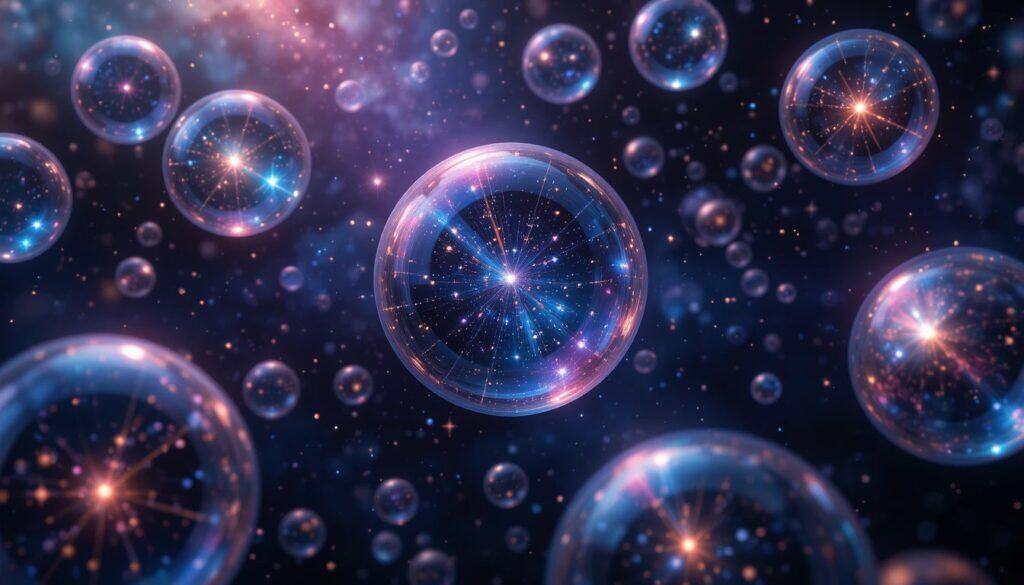
The many-worlds interpretation of quantum mechanics implies that each quantum measurement results in a divergence of reality into several possible outcomes. Cosmic inflation might be the ultimate expression of this branching process, creating streams of space-time that flow into separate channels of existence.
Each quantum fluctuation during the cosmic inflation represents a moment of branching, where the universe splits into multiple possibilities. The amplitude of the fluctuation determines which branch becomes the dominant reality, while the other possibilities continue to exist as parallel streams. This creates a river delta of realities, with each channel representing a different possible history of the universe.
The stream metaphor captures the dynamic nature of this branching process. Unlike static parallel universes, these streams of reality are constantly diverging and potentially converging as quantum events unfold. The flow of time itself becomes multiple streams, each carrying its own version of causality and physical law.
Hugh Everett’s original many-worlds interpretation focused on quantum measurements in laboratory settings. But inflation extends this branching to cosmic scales, where every quantum fluctuation in the early universe created new branches of reality. The cosmic microwave background becomes a fossil record of these ancient branchings, showing us the quantum events that shaped our particular stream of space-time.
This stream-like structure of the multiverse suggests that reality is fundamentally fluid rather than fixed. Our universe represents just one current in an infinite ocean of possibilities, connected to but separate from countless other streams of existence. The boundaries between these streams are not walls but phase transitions, regions where the flow of one reality gradually transforms into another.
Table 9: Multiverse Classification by Branching Mechanism
| Mechanism | Type | Scale | Connectivity | Observable Effects |
|---|---|---|---|---|
| Eternal Cosmic Inflation | Bubble Universes | Cosmic Horizon | Causally Disconnected | Possible CMB signatures |
| Quantum Decoherence | Many Worlds | Microscopic | Quantum Entanglement | Interference patterns |
| Vacuum Decay | Phase Transitions | Variable | Barrier Tunneling | Metastable vacuum states |
| Fractal Inflation | Nested Hierarchies | Self-Similar | Recursive Structure | Scale-invariant patterns |
| String Compactification | Landscape Universes | Planck Scale | Geometric Topology | Fundamental constants |
Conclusion: Infinite Canvas of Cosmic Inflation
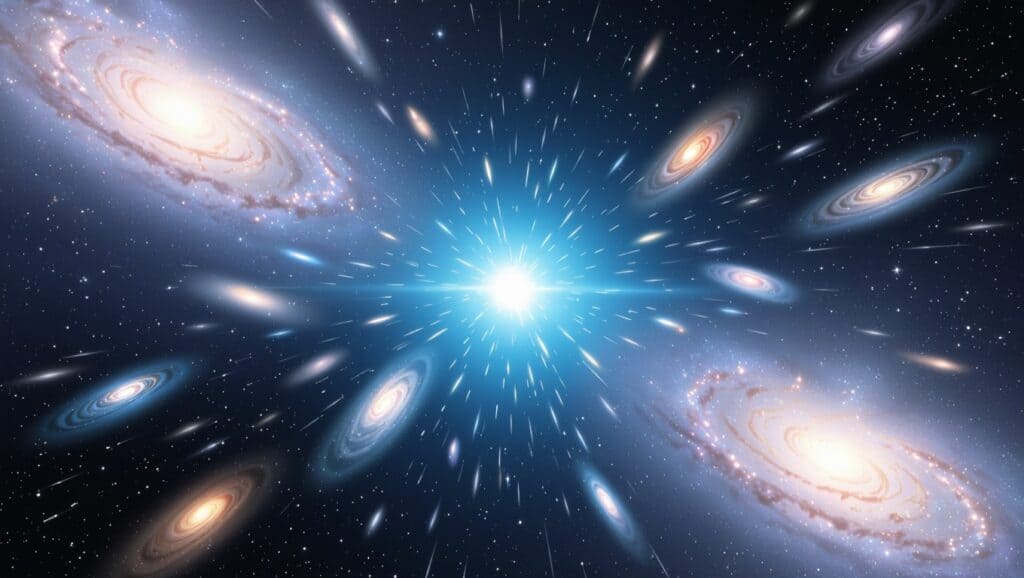
Cosmic inflation transformed our understanding of the universe from a single, isolated reality into a vast tapestry of interconnected possibilities. The violent expansion of space-time during the first fraction of a second after the Big Bang did more than solve the horizon and flatness problems of standard cosmology. It opened the door to a multiverse of staggering complexity and infinite creative potential.
The eight mechanisms explored in this article represent different facets of inflation’s universe-creating power. From the causal horizons that isolated distant regions to the quantum fluctuations that fine-tuned physical constants, each process contributes to the rich structure of the multiverse. The bubble universes of eternal cosmic inflation, the fractal hierarchies of nested realities, and the streaming branches of quantum possibility all emerge from the same fundamental process of cosmic expansion.
This inflationary multiverse challenges our most basic assumptions about the nature of reality. The universe we observe might be just one bubble in an infinite foam, one branch in an eternal tree, one stream in a vast river delta of possibilities. The laws of physics that seem so fundamental to our existence might be local bylaws, applying only to our particular corner of a much larger reality.
Yet this vast multiplicity of universes also highlights the special nature of our own cosmic home. The precise balance of forces that allows for stable atoms, burning stars, and complex chemistry might be rare even in an infinite multiverse. The anthropic principle suggests that we find ourselves in this particular universe precisely because it is one of the few that can support observers capable of contemplating their own existence.
The pursuit of proof for this multiverse has emerged as one of the significant endeavors in contemporary science. Although the direct observation of alternate universes is currently unattainable, the faint indicators of their presence may be concealed within the cosmic microwave background, in the arrangement of matter and energy throughout space, or in the fundamental constants of physics themselves. Each new discovery brings us closer to understanding whether we truly live in a multiverse or whether our universe stands alone in the cosmic dark.
Cosmic inflation has given us a universe of infinite possibility, where every quantum fluctuation spawns new realities and every moment of expansion creates new worlds. The inflationary multiverse represents the ultimate expression of nature’s creativity, a cosmic canvas so vast that it contains not just our universe but every universe that mathematics allows to exist. In this infinite expanse of space and time, cosmic inflation emerges not just as the creator of our reality but as the eternal artist painting new worlds across the endless canvas of existence.
Table 10: Multiverse Implications for Cosmology and Physics
| Implication | Traditional Cosmology | Inflationary Multiverse | Observational Status | Future Prospects |
|---|---|---|---|---|
| Universe Uniqueness | Single universe | Infinite universes | Horizon problem solved | CMB anomaly studies |
| Physical Constants | Universal values | Locally varying | Anthropic fine-tuning | Precision measurements |
| Quantum Mechanics | Copenhagen interpretation | Many-worlds realization | Decoherence studies | Quantum gravity tests |
| Cosmic Evolution | Linear progression | Branching possibilities | Structure formation | Advanced simulations |
| Ultimate Fate | Heat death or collapse | Eternal creation | Accelerating expansion | Dark energy research |

